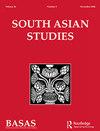The Impermanent Settlement: Bengal’s Riparian Landscape, 1793–1846
IF 0.7
0 ASIAN STUDIES
引用次数: 4
Abstract
In 1793, the East India Company (EIC) drafted the Permanent Settlement, a legal regime designed to stabilize property ownership and incentivize landowning zamindars to improve the agricultural productivity of their land by fixing their tax obligations in perpetuity. The EIC imposed this legal fiction of stability over the unstable riparian landscape of Bengal. As accretion and erosion continued to alter the size of zamindari holdings along riverbanks, the EIC’s bureaucracy was overwhelmed with petitions from landholders demanding reassessment of their settlement based on the material conditions of their property. Despite several regulations designed to bring alluvial land under the Permanent Settlement, the EIC was never able create a legal mechanism that could accommodate the fluctuations of the landscape; they refused to alter their foundational premise that once the landscape was permanently measured and ordered, it would bring monetary and moral improvement to the zamindars which, in turn, would increase their acceptance of EIC rule. Because of this gap between the law and the material conditions it governed, the ability of the Permanent Settlement to regulate the impermanent landscape of Bengal remained incomplete. By 1846, the EIC responded to this contradiction with a moratorium on all alluvial assessment, thus allowing them to maintain their legal fiction in the face of mounting environmental challenges.临时定居:孟加拉的河岸景观,1793-1846
1793年,东印度公司(EIC)起草了《永久定居法》(Permanent Settlement),这是一种法律制度,旨在稳定财产所有权,并通过永久固定土地所有者的纳税义务,激励土地所有者提高土地的农业生产力。EIC在孟加拉不稳定的河岸景观上强加了这种法律上的稳定。随着河岸上扎明达里土地的不断增加和侵蚀,EIC的官僚机构被来自土地所有者的请愿书所淹没,他们要求根据他们财产的物质条件重新评估他们的定居点。尽管有几项法规旨在将冲积土地纳入永久定居点,但EIC从未能够建立一个能够适应景观波动的法律机制;他们拒绝改变他们的基本前提,即一旦景观被永久测量和有序,它将给扎门达尔带来货币和道德上的改善,这反过来又会增加他们对EIC规则的接受度。由于法律和它所管辖的物质条件之间的差距,永久定居点调节孟加拉无常景观的能力仍然不完整。到1846年,环境保护委员会对这一矛盾作出了回应,暂停了所有冲积物评估,从而使他们能够在面对日益严峻的环境挑战时维持其法律虚构。
本文章由计算机程序翻译,如有差异,请以英文原文为准。
求助全文
约1分钟内获得全文
求助全文

 求助内容:
求助内容: 应助结果提醒方式:
应助结果提醒方式:


